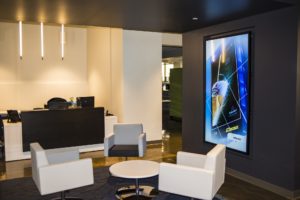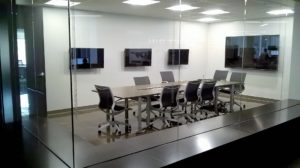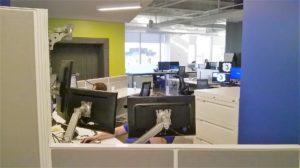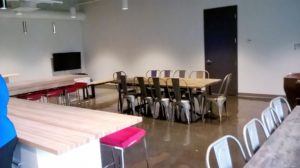Earlier this fall I was invited to visit BroadSign at their new offices in downtown Montreal. It was the fourth move since the company was incorporated in 2004 under this brand name.
Every move marked a milestone in BroadSign’s ascension to the top of the list of digital signage software makers. When it started, there were a few dozen of other software vendors, and the competition was already tough. Today, there are several hundred of competitors, each claiming to be a ‘leading provider’.
It took a unique product and marketing strategy to cut through the enormous clutter and rise to the top in a most saturated market.
Since 2008, BroadSign has been consistently ranked in the top three digital signage software manufacturers by various sources. Since 2011, it has been named No. 1 by the DailyDOOH trade publication, and since 2014 the company has been occupying the number one position in Frost & Sullivan’s rankings.
The Secret Sauce of Broadsign Digital Signage Software.
What is behind the company’s success? At an early stage, the core team realized that the future of digital signage, aka digital out-of-home (DOOH), would be defined by scale and efficiency, and that it would be fueled by advertising dollars. Hence the efforts were focused on making the platform media buyer-friendly, campaign performance transparent and making the workflow automated.
BroadSign was one of the first software companies in the business to introduce the concept of a content loop, as the digital-age alternative to the traditional broadcast-style manual playlists. The dynamic content loop allows network operators to schedule campaigns by setting the rules by which content is played back, and then each player in the field plays its content accordingly, until the rules change.
From the beginning, BroadSign adopted the Software-as-a-Service business model, to make the software affordable to network operators, many of whom liked the pay-as-you-grow approach.
Following years of R&D and listening to clients, the strategy has paid off. Today BroadSign powers over 260 DOOH networks, some of them – the largest ones in their verticals – spanning more than 40 countries. 80,000+ media players run over 100,000 screens, which is the largest number of digital signs connected on the same platform.
BroadSign’s renowned campaign reporting system allows advertisers to track the progress of their ads in near real time, and obtain a full campaign performance report in the end.
Many of the spectacular campaigns we see and read about in the press are executed with the help of BroadSign software, including those by JCDecaux, oOh! Media, and ads on the Times Square screens.
Programmatic DOOH and Mobile Integration.
In effect, being de facto the largest DOOH network aggregator in the world, BroadSign has quietly implemented the much-talked-about programmatic media buying component within its platform. The campaigns can be bought by audience parameters, and the ad content can be either scheduled or triggered by external factors such as weather, proximity of target audience or other criteria set by the advertiser.
Everything is in place for programmatic cross-network media buying as well. In this respect, BroadSign appears to be the platform that is closest to making the programmatic DOOH buying a reality for agencies and brands.
The architecture of the platform also makes it easy for any external trading desk or cross-network buying platform to plug into the BroadSign’s connected universe of screens.
The software enables integration of any DOOH campaign with mobile, allowing viewers to interact with the screens via their smartphones. Such interactions are tracked and summarized in user-friendly reports.
99.999 Percent Uptime and 100 Percent Client Data Security.
The current scale of the operation and its accelerating growth require constant upgrades in reliability and platform security.
Bryan Mongeau, the company’s VP, Technology, was proud to show me the added redundancy and security features. The R&D and testing areas, as well as the amount of hardware, have tripled in size, compared to the old premises.
COO Jean Beaudry told me it was hard to find a commercial space downtown that met the power requirements for the development and testing. As for the client servers and data center – they are hosted in a Fort-Knox-like facility in a telecom building next door. Jean said that even in case of a major power shutdown in the city, BroadSign can still run its operations full scale on redundant backup generators.
The People of Broadsign.
To support the growth, the company had to double the number of employees in the past two years. Developers represent 40 percent of its workforce while 20 percent are in services and 12 percent – in sales.
In addition to Montreal, BroadSign now has sales offices on both coasts of the US, in Germany, the Netherlands, Belgium and APAC.
The new Montreal headquarters occupy the whole floor in a prestigious high-rise not far from the McGill University campus. Following CEO Burr Smith’s vision, the space is designed so as to give everyone access to the floor-to-ceiling windows, whereas all executive offices are built in the middle, away from the windows.
… and their Kitchen
I have worked in companies where refrigerators were fully stocked with free snacks and soft drinks. BroadSign’s creativity took the new kitchen in a different direction. In addition to a fancy espresso machine and other high-tech food gadgets I was shown… a free beer tap. According to the management, “no one has been abusing the faucet” (and I could not spot any surveillance cameras around it).
The huge dining and recreation areas serve as a “social hearth” for the team that now has more than 60 employees.
Free beer to blame, or not, they all looked like one happy family to me.
Disclosure: BroadSign is an advertiser with Digital Signage Pulse.








